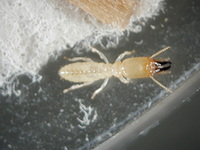
Termite Info
There are approximately 2,500 species of termites worldwide, but only four species occur naturally in Missouri. All of these species are subterranean, meaning they live in the soil and in wood that is in contact with soil. Subterranean termites cause the most damage of any termite species. They build distinctive tunnels, which look like and are referred to as mud tubes, to reach food sources and protect themselves from open air. They eat wood 24 hours a day, seven days a week, using their saw-toothed jaws to bite off small fragments of wood one piece at a time. Over time they will critically damage a building structure, sometimes causing a total collapse.
In nature termites are considered beneficial because they help break down and release nutrients from dead wood and other cellulose materials back into the soil. In human environments, they are considered serious pests. Due to their widespread distribution, subterranean termites are responsible for most of the damage caused annually in the United States. Approximately $4.5 billion is spent annually in the United States to control infestations and repair the damage they cause.
ID
Termites have been on this planet for more than 120 million years. Known as ‘silent destroyers’ within the pest control industry, you do NOT want to procrastinate if you are unlucky enough to find this pest in your home. Instead of attempting do-it-yourself measures to eradicate an infestation, always work with a licensed pest control professional who can correctly treat infestations before they get worse. There are three distinct types of subterranean termites with easily distinguished physical differences, if you know what to look for.
The reproductives include the king, queen and alates. Like many other social insects, the queen is the largest while the king is much smaller. Alates are also known as swarmers. They have long, dark brown to almost black bodies and translucent, slightly milky-colored wings. Their bodies typically measure about ¼ to ½ inch in length and their wings may have a few barely visible hairs. You will generally see swarmers from late spring through the fall seasons. Workers and soldiers do not have wings. Workers are about ¼ inch or less in length and have cream colored bodies. Workers have small jaws that help them chew away at wood and move materials while soldiers have large, fearsome mandibles to help them to defend the nest from invaders. They have rectangular shaped heads and their bodies are flat and wide. Workers have cream-colored, pale heads, while the head of the soldier is darker and more brownish in color.
Social insects like termites live in large groups, share a nest and have important biological roles, known as castes, among individuals within a colony. Termite castes include eggs, larvae, workers, soldiers, nymphs and reproductives.




Reproductives (swarmers) Shiny brownish to black in color, alates are produced in mature colonies and emerge at certain seasons of the year to make dispersal flights. During the period they are called swarmers. They are often confused with ant swarmers but the two are easily distinguished from one another. After flying away from their home colony, swarmers shed their wings and pair up. Each pair starts a new colony by constructing a protective cell in the soil adjacent to wood or other food source. Mating and egg production begin in this cell and a new colony is born.

In natural ecosystems termites are considered beneficial because they help release nutrients from dead wood and other cellulose materials into the soil. In human environments, they are considered serious pests. Above you can see workers on the left, and on the right a termite alate with wings, ready to fly and start a new colony.
Infestations
Subterranean termites invade homes from the soil surrounding and underneath a structure. If the soil is not in direct contact with the wood they will sometimes build shelter tubes (mud tubes) extending from the soil, across the foundation and into the structural wood. They might also enter through cracks in the slab where plumbing or electrical lines provide an ingress.
Termites will do significant structural damage over the course of several months. Because they prefer not to be exposed to the outside environment at all, they can be very difficult to detect if you don’t have the necessary training. Infested wood can look perfectly normal on the outside and be totally riddled with galleries just beneath the surface.
Checking for Termites
- Look for the presence of mud tubes on the exterior of the home. Mud tubes look like long tunnels made of wood and soil.
- Soft wood in the home that sounds hollow when tapped.
- Darkening or blistering of wood structures
- Small piles of feces that resemble sawdust.
- Discarded wings near doors or on windowsills.
These are all indications that you may have an infestation. It is very important that you contact a pest control professional to protect the value and structural integrity of your home.
Why Choose Our Services ?
We have experience with every phase of termite control, from pre-construction to protected historical landmarks. We can provide effective and reasonably priced extermination and prevention for any homeowner and we also provide reasonably priced pre-sale inspections for local realtors. Call us today for a FREE inspection!
Mizzou Extension. “Termites.” University of Missouri Extension, 2023, https://extension.missouri.edu/publications/g7420.Wikipedia contributors. (2023, March 8). Termite. In Wikipedia, The Free Encyclopedia. Retrieved from https://en.wikipedia.org/wiki/Termite
PestWorld. “Subterranean Termites.” PestWorld, 2023, https://www.pestworld.org/pest-guide/termites/subterranean-termites/.